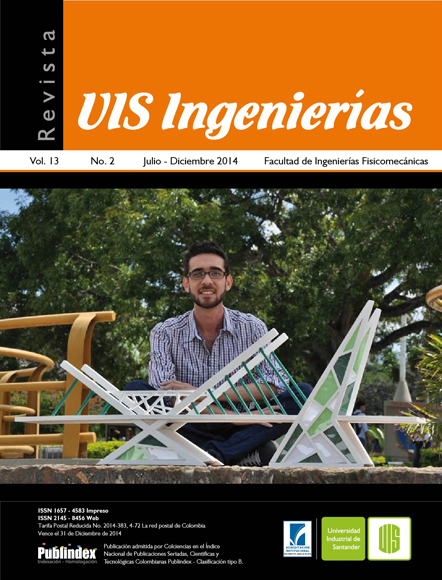Publicado 2014-03-03
Palabras clave
- negro de humo,
- Caucho natural,
- nano alúmina,
- micro alúmina,
- vulcanización
Cómo citar
Resumen
La formulación de compuestos de caucho, es el arte y la ciencia de seleccionar y combinar cauchos y aditivos para producir un compuesto con las propiedades químicas, físicas y mecánicas necesarias en el producto terminado, así como para facilitar el procesamiento. Esta formulación generalmente contiene diferentes compuestos que tienen una función específca, y por lo tanto, con un impacto en las propiedades, procesabilidad y costos del producto fnal. Estos componentes pueden clasifcarse en varias categorías: polímeros (caucho natural y sintético), sistemas de vulcanización (agentes de vulcanización, acelerador, activador o inhibidor), carga (reforzante, no reforzante), antidegradantes (antioxidante, antiozonante), lubricantes y extendedores, pigmentos de color y otros aditivos especiales.
En la presente investigación se estudiaron los efectos generados por la adición de negro de humo y alúmina (Al2O3) como cargas reforzantes de un caucho natural. Se realizaron ensayos de dureza, tensión, dispersión morfológica, reometría de vulcanización, microscopia óptica y reometría de torque, para determinar las propiedades de las mezclas.
Fue posible determinar que tanto el negro de humo como la carga blanca de alúmina infuyen principalmente en propiedades físico mecánicas de la mezcla como viscosidad, dureza y resistencia a la tensión. Estos resultados contribuyen a posibles aplicaciones en nuevos desarrollos y productos en caucho natural al utilizar cargas blancas reforzantes.
Descargas
Referencias
- ANSARIFAR, A., Shiah, S. F., & Bennett, M. (2006). Optimising the chemical bonding between silanised silica nanofiller and natural rubber and assessing its effects on the properties of the rubber. International Journal of Adhesion and Adhesives, 26(6), 454–463. doi:10.1016/j.ijadhadh.2005.06.008
- BHATTACHARYA, M; BHOWMICK, K. (2010). Analysis of wear characteristics of natural rubber nanocomposites. Wear, 269(1-2), 152–166. doi:10.1016/j.wear.2010.03.022
- BITINIS, N. et al., (2012). Physicochemical properties of organoclay filled polylactic acid/natural rubber blend bionanocomposites. Composites Science and Technology, 72(2), 305–313. doi:10.1016/j. compscitech.2011.11.018
- BOKOBZA, L; CHAUVIN, J.-P. (2005). Reinforcement of natural rubber: use of in situ generated silicas and nanofibres of sepiolite. Polymer, 46(12), 4144–4151. doi:10.1016/j.polymer.2005.02.048
- DE GREIFF, M; HERNANDEZ, A; CASTAÑO, N. (2001). Diplomatura en tecnología del caucho. Medellín, Colombia.
- FAN, Q. et al., (2014). Investigation of dynamic characteristics of nano-size calcium carbonate added in natural rubber vulcanizate. Composites Part B: Engineering, 60, 561–567. doi:10.1016/j. compositesb.2014.01.010
- FISCHER, H; (2003). Polymer nanocomposites: from fundamental research to specific applications. Materials Science and Engineering: C, 23(6-8), 763– 772. doi:10.1016/j.msec.2003.09.148
- GACITA, W., ALDO, A; ZHANG, J. (2005). Polymer nanocomposites: synthetic and natural fillers. Ciencia Y Tecnologia, 7(3), 159–178.
- HAKIM, N; ISMAIL, H. (2008). The Comparison of Organoclay with Respect to Silica on Properties of Natural Rubber Nanocomposites. Journal of Reinforced Plastics and Composites, 28(12), 1417–1431. doi:10.1177/0731684408089504
- HERNÁNDEZ, M., Bernal, M. D. M., Verdejo, R. (2012). Overall performance of natural rubber/graphene nanocomposites. Composites Science and Technology, 73, 40–46. doi:10.1016/j.compscitech.2012.08.012
- IDRUS, S; ISMAIL, H; PALANIANDY, S. (2011). Study of the effect of different shapes of ultrafine silica as fillers in natural rubber compounds. Polymer Testing, 30(2), 251–259. doi:10.1016/j. polymertesting.2010.10.002
- CARRETERO, J; VERDEJO, R; ARROYO, M M. Á. L. M. (2009). Nuevos avances en el desarrollo de nanocompuestos elastoméricos. Latinoamericana de Metalurgia Y Materiales, 1, 33–34. KOHJIYA, S; KATO, A; IKEDA, Y. (2008). Visualization of nanostructure of soft matter by 3D-TEM: Nanoparticles in a natural rubber matrix. Progress in Polymer Science, 33(10), 979–997. doi:10.1016/j.progpolymsci.2008.06.001
- KONAR, B; ROY, K; PARIYA, K. (2010). Study on the Effect of Nano and Active Particles of Alumina on Natural Rubber–Alumina Composites in the Presence of Epoxidized Natural Rubber as Compatibilizer. Journal of Macromolecular Science, Part A, 47(5), 416–422. doi:10.1080/10601321003659531
- MOHAMAD, N. et al., (2010). Correlation of Filler Loading and Silane Coupling Agent on the Physical Characteristics of Epoxidized Natural Rubber-Alumina Nanoparticles Composites. Journal of Elastomers and Plastics, 42(4), 331–346. doi:10.1177/0095244310368125
- MOHAMAD, N. et al., (2009). Epoxidised natural rubber-alumina nanoparticle composites: effect of filler loading on the tensile properties. Solid State Science and Technology, 17(2), 133–143. Nanocomposites a Global Market Report. (2012). Tomado de http://www.strategyr.com/Nanocomposites_ Market_Report.asp
- PAUCA, A. et al., (2010). Síntesis y caracterización de alúmina nanométrica. Boletín de Ciencias de La Tierra, (28), 51–60.
- PFAENDNER, R. (2010). Nanocomposites: Industrial opportunity or challenge? Polymer Degradation and Stability, 95(3), 369–373. doi:10.1016/j. polymdegradstab.2009.11.019
- POLYMER nanocomposites drive opportunities in the automotive sector. (2012). Retrieved from http://www. nanowerk.com/spotlight/spotid=23934.php
- RAMORINO, G., Bignotti, F., Pandini, S., & Riccò, T. (2009). Mechanical reinforcement in natural rubber/ organoclay nanocomposites. Composites Science and Technology, 69(7-8), 1206–1211. doi:10.1016/j. compscitech.2009.02.023
- RAMOS DEL VALLE, F; SANCHEZ, S. (2003). Vulcanización y formulación de hules. (G. noriega Editores, Ed.) (p. 148). México, DF.
- RATTANASOM, N; PRASERTSRI, S. (2012). Mechanical properties, gas permeability and cut growth behaviour of natural rubber vulcanizates: Influence of clay types and clay/carbon black ratios. Polymer Testing, 31(5), 645–653. doi:10.1016/j. polymertesting.2012.04.001
- REZENDE, A. (2010). Natural rubber-clay nanocomposites: Mechanical and structural properties. Polymer, 51(16), 3644–3652. doi:10.1016/j. polymer.2010.06.026
- VILLEGAS, A. et al., (2007). Comparación de la resistencia a la flexión entre una matriz de alumina nanométrica reforzada con un material amorfo tipo
- LA2O3.AL2O3.3SiO2 con un producto dental de óxido de aluminio infiltrado. Scientia et Technica, XIII, 419– 424.
- VILLEGAS, P; TAYLOR, V; ARANGO, S. (2014). Caracterización biológica y mecánica de α - alumina nano y micrométrica como material potencial para reconstrucción de tejido oseo., 1–14.

